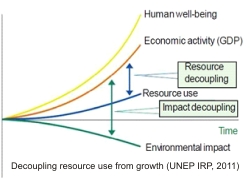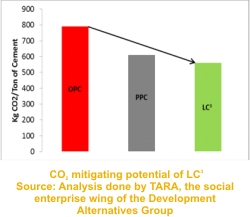|
Innovations for Climate
Change Mitigation: LC3
Given
the rise in urbanisation, extraction and use of natural
resou Waste Materials and Building Product Standardisation Taking this into consideration, the Bureau of Indian Standards, the National Standards body of the country, has been considering the scarcity of sand and coarse aggregates from natural resources, and has evolved a number of alternatives which are aimed at conservation of natural resources apart from promoting use of various waste materials without compromising on quality. These measures have included permitting the Concrete Code (IS 456) as also in the National Building Code of India i.e. the use of slag - waste from the steel industry, fly ash waste - waste from thermal power plants, crushed over-burnt bricks and tiles - waste from clay brick and the tile industry, in plain cement concrete as an alternative to sand/natural aggregate, subject to fulfilling the requirements of the Code. Further for the 15 varieties of cements, for which Indian Standards have been developed, more than three-fourth of the cement produced in the country pertains to Portland Pozzolana Cement and Portland Slag Cement, popularly known in the market as blended cements (BIS, 2017). Research continues to take place to increase the use of supplementary cementitious materials to reduce the clinker factor in cements.
Innovation for Climate Change Mitigation:
LC3 In this sphere, Limestone Calcined Clay Cement, commonly known as LC3 has made a successful break-through in both innovation in cleaner technology as well as resource efficiency and use of secondary raw materials. LC3 provides the perfect cement blend that has a mix design of 50% clinker, 15% non-cement grate (waste) limestone, 30% waste china clay (overburden) from mines and 5% gypsum. The blend has two major advantages for sustainable production. Firstly, about 45% of raw material in the blend is waste and secondly clinker content is reduced to 50%. Life Cycle Analysis reveals that LC3 production can reduce carbon dioxide emissions up to 30% and save up to 50% limestone as compared to conventional cement. The LC3 cement is also found to have comparable durability and strength as compared to conventional cement. Further, the most suitable clays for production of LC3 are overburdens (waste clay) from china clay mines. Barriers to Upscaling Production of LC3 In the present Indian Standards, replacement of cement with calcined clay as a pozzolan is limited to 25% (IS 1489) and limestone as performance improver is limited to 5% (IS 269) (Medepalli, Shah, & Bishnoi, 2016). Resistance in the standardisation for the use of LC3 has mainly been in the form of poor technical understanding of the process and the strong lobby of the Indian construction sector. Various structural applications require various compressive strength and therefore the conventional approach to ‘one-type fits all’ causes a hindrance to innovation and flexibility to exploit local opportunities for raw materials, both for clinker and for supplementary materials like fillers. Thus, while the Indian cement market continues to wait for the Indian standard on LC3 based building materials, a necessary change in the standardisation process is the need for assessment of various applications and the flexibility that can allow for greater use of supplementary cementious materials (in this case industrial waste) and thereby reducing the use of natural resources. This range in standards for materials will ensure a larger market for building products as well as allow for greater innovation in increasing the use of waste materials, thus reducing dependence on natural resources.
Mapping Awareness at the International
Level At the international level, LC3 has gained a lot of positive response. Several African countries like Ghana, Ivory Coast, Togo, Benin, Mauritania, Uganda etc. have shown interest in identifying the potential of LC3 in their region. At the recent UN Climate Change Conference (COP23) in Bonn, Germany, 6th- 17th November 2017; TARA, the social enterprise wing of the Development Alternatives Group along with its project partners set up a LC3 exhibition to showcase the potential of LC3 in mitigating climate change. The cement value chain makes up a large propotion of all economies, including a range of stakeholders from large companies to individuals. While the cement industry, especially under the Cement Sustainability Initiative tries hard to increase efficiency and environmental sustainability in the sector, commitment of the government through public procurement policies, stringent policies on use of natural aggregates and incentives for research and development are the need of the hour. ■
References:
Pratibha Caleb
|
 rce
materials, further leading to greater generation of waste is bound to
create a vicious cycle of production and consumption. However, several
economies worldwide are attempting to ‘decouple’ use of natural
resources from the growth of the economy. This is referred to as
‘Resource Decoupling’, which means reducing the rate of use of (primary)
resources per unit of economic activity. This understanding of
‘dematerialisation’ is based on the concept of using less materials,
energy, water and land for the same economic output, and it is connected
with an increase in the efficiency with which resources are used (Caleb,
et al., 2017).
rce
materials, further leading to greater generation of waste is bound to
create a vicious cycle of production and consumption. However, several
economies worldwide are attempting to ‘decouple’ use of natural
resources from the growth of the economy. This is referred to as
‘Resource Decoupling’, which means reducing the rate of use of (primary)
resources per unit of economic activity. This understanding of
‘dematerialisation’ is based on the concept of using less materials,
energy, water and land for the same economic output, and it is connected
with an increase in the efficiency with which resources are used (Caleb,
et al., 2017). 
